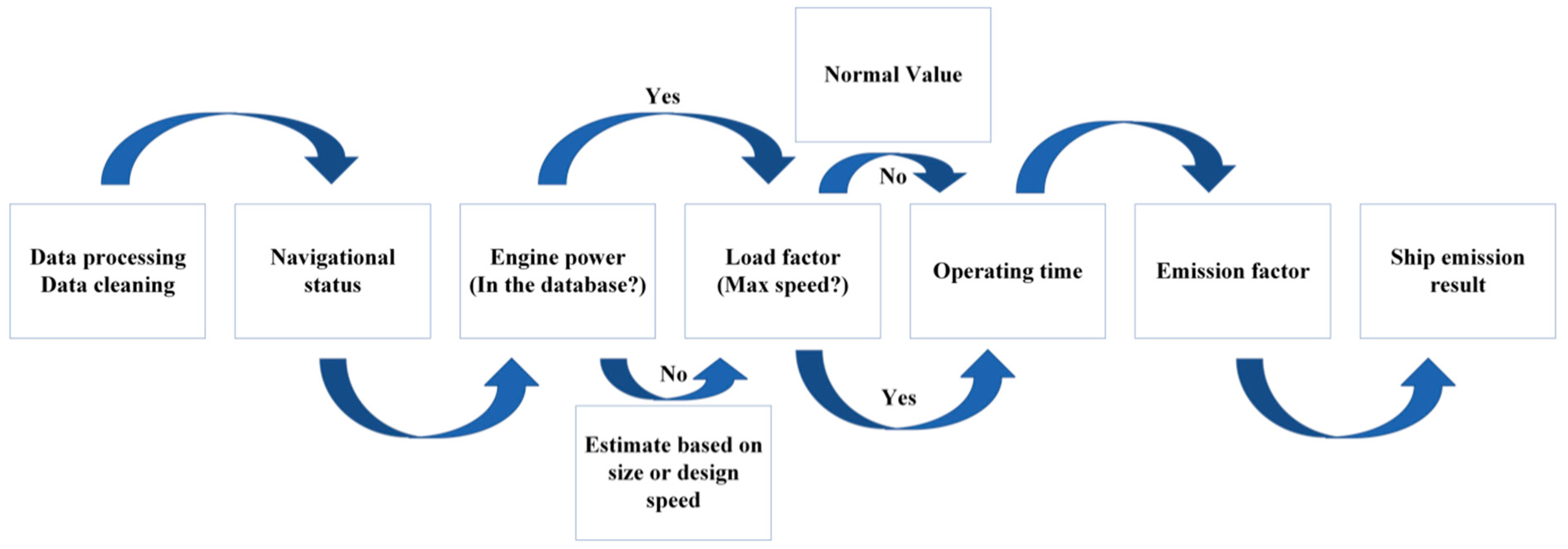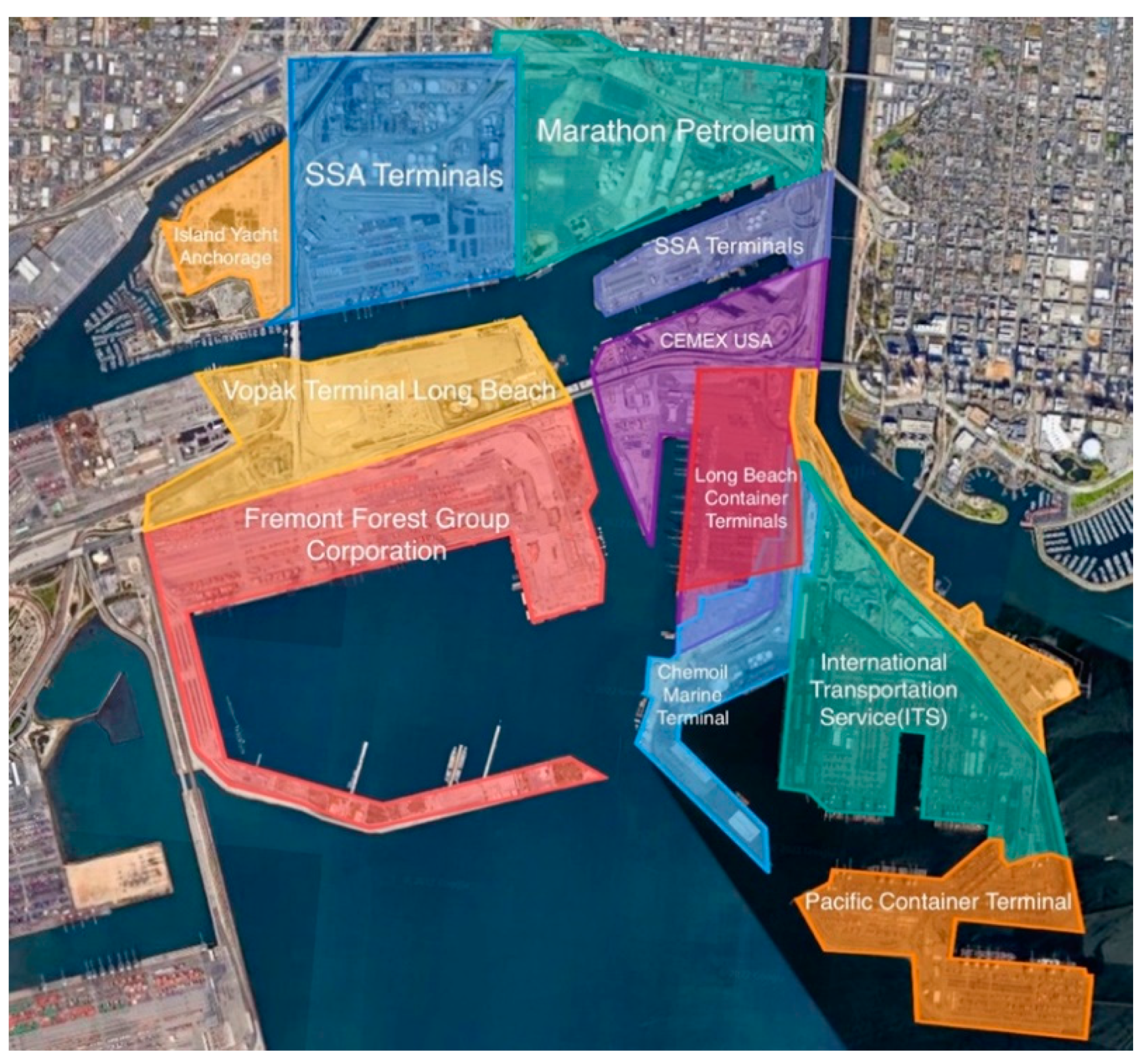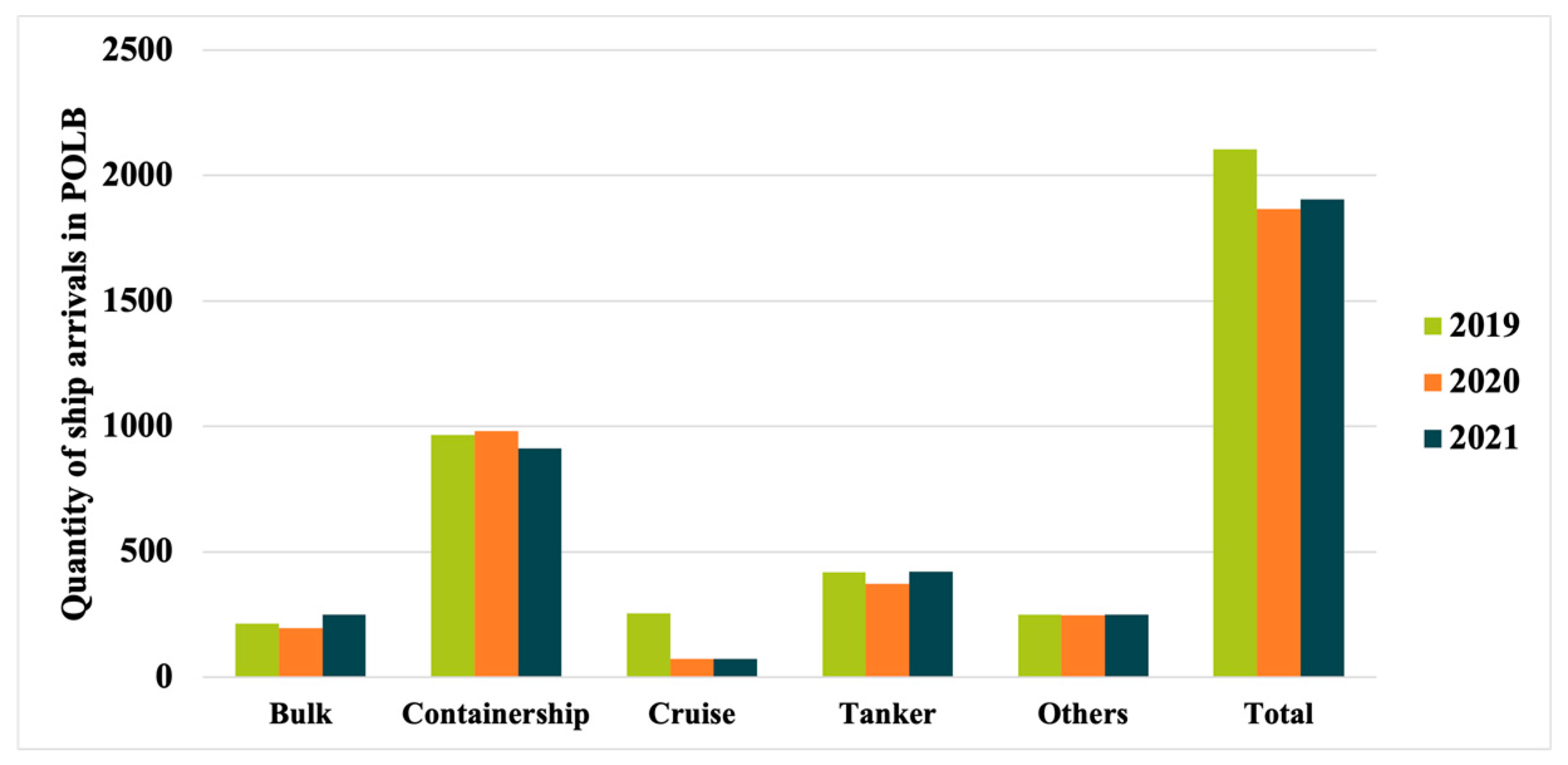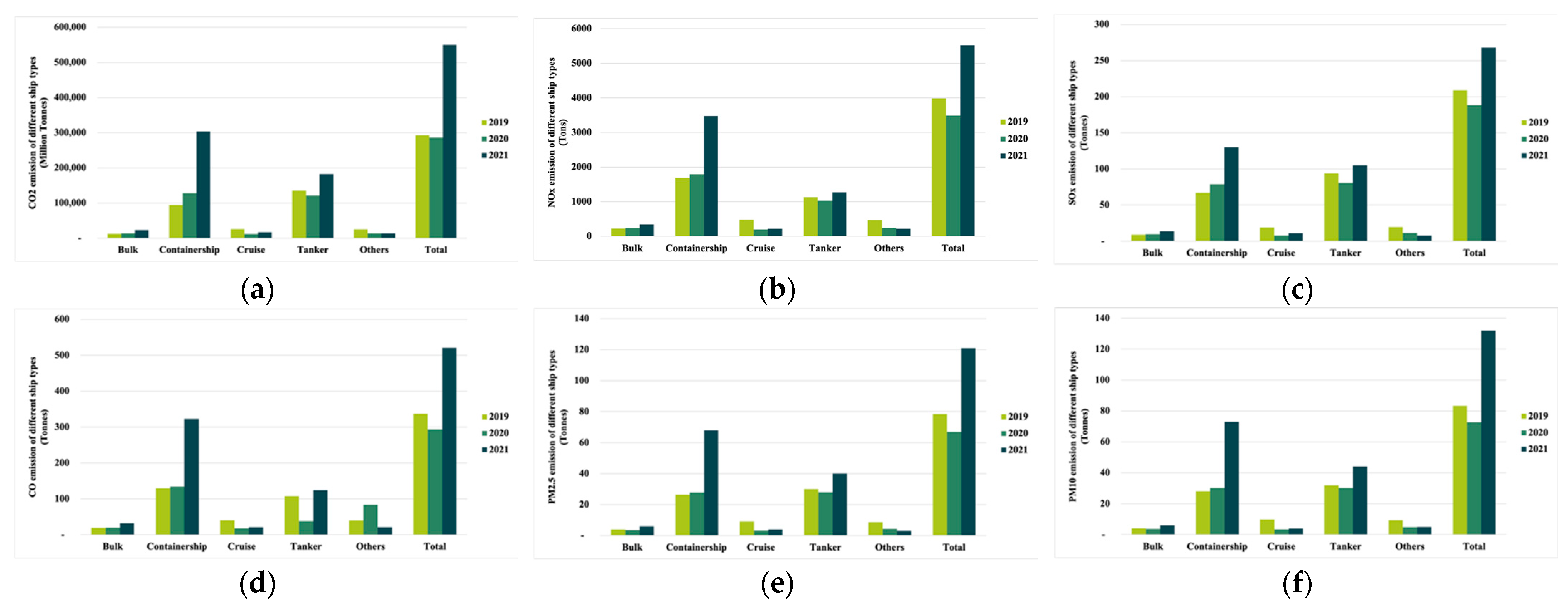Impact of Disruption on Ship Emissions in Port: Case of Pandemic in Long Beach
Abstract
:1. Introduction
- (1)
- We establish a high-precision estimation method for missing ship data to improve the existing ””bottom-up” approach for calculating ship emissions.
- (2)
- We detail the emissions based on different ship types and ship engines in the POLB region before and after the COVID pandemic.
- (3)
- As the Port of Long Beach has adopted new shore power policies, the calculations should be revised in line with the policies. Through the results, we discuss the significance of the shore power policy.
2. Related Work
2.1. Calculation Method of Ship Emissions
2.2. Ship Emissions under the Pandemic
2.3. Literature Gap
3. Model and Methodology
3.1. Data Processing
3.2. Navigational Status
3.3. Ship Emission Estimation Model
3.3.1. Motion-Based Formulae for Calculating Ship Emissions
3.3.2. Engine Power Calculation and Estimation
3.3.3. Load Factors Estimation Based on Operating Modes
3.3.4. Operating Time Statistics
3.3.5. Emission Factors for Different Engine Types
4. Experiment and Analysis
4.1. Description of the Study Area and Data Source
4.2. Emissions from Ship Quantity and Different Types
4.3. Emission Analysis of Different Ship Operating Conditions and Waiting Time
4.4. Uncertainty Factors
- (1)
- Issues resulted from the exclusion of data for certain smaller vessels. When processing the AIS data, this study observed that several smaller ships had incomplete AIS data. Inadequate information regarding their operating period or range will result in variation. The inability to accurately anticipate the engine power of tiny vessels also contributes to inaccurate calculations.
- (2)
- Although some missing ship engine data can be calculated using coupled formulas, this procedure contains a certain degree of inaccuracy, which does not ensure the calculation’s precision. For some ships lacking essential parameters such as length, breadth, draught, and design speed, these estimates must be averaged based on similar ship types, which can also result in mistakes.
- (3)
- Weather, waves, and other variables will impact a ship’s fuel use and emissions. In addition, for some vessels with speeds below 0.5 knots, this study assumed that they were sailing under the influence of their engines, neglecting variations in their position and speed caused by weather, waves, etc.
- (4)
- Not all ships utilise the same fuel; therefore, energy variations may influence a ship’s emission parameters. Consequently, it is impossible to monitor the emissions of numerous substances precisely.
4.5. Discussion
5. Conclusions
- (1)
- This study gives an optimised approach for calculating ship emissions and proposes a solution to the problem of erroneous emission estimations caused by lacking data for some ships. The method can be applied to future ship emission monitoring and policy design.
- (2)
- This study details the vessel emissions in the POLB region before and after the pandemic. Changes in ship emissions are systematically analysed in four dimensions: different emissions, different ship types, different ship engines, and different ship states.
- (3)
- This study assesses the shore power policy and demonstrates the significance of its implementation through calculations. The implementation of the shore power policy can be extended to many ports in many countries to achieve environmental sustainability development in the shipping industry. We also envisage new rules such as optimising ship scheduling in port areas, changing the flow of port operations, and increasing the demand for fuel. The analysis of emissions for various vessel types and operating modes presented in this study can be used to establish and modify rules.
Author Contributions
Funding
Institutional Review Board Statement
Informed Consent Statement
Data Availability Statement
Conflicts of Interest
References
- Guo, S.; Zheng, S.; Hu, Y.; Hong, J.; Wu, X.; Tang, M. Embodied energy use in the global construction industry. Appl. Energy 2019, 256, 113838. [Google Scholar] [CrossRef]
- Poulsen, R.T.; Ponte, S.; Sornn-Friese, H. Environmental upgrading in global value chains: The potential and limitations of ports in the greening of maritime transport. Geoforum 2018, 89, 83–95. [Google Scholar] [CrossRef]
- Yang, D.; Wu, L.; Wang, S.; Jia, H.; Li, K.X. How big data enriches maritime research—A critical review of Automatic Identification System (AIS) data applications. Transp. Rev. 2019, 39, 755–773. [Google Scholar] [CrossRef]
- Sui, C.; de Vos, P.; Stapersma, D.; Visser, K.; Ding, Y. Fuel consumption and emissions of ocean-going cargo ship with hybrid propulsion and different fuels over voyage. J. Mar. Sci. Eng. 2020, 8, 588. [Google Scholar] [CrossRef]
- Ytreberg, E.; Åström, S.; Fridell, E. Valuating environmental impacts from ship emissions–The marine perspective. J. Environ. Manag. 2021, 282, 111958. [Google Scholar] [CrossRef] [PubMed]
- Gan, L.; Che, W.; Zhou, M.; Zhou, C.; Zheng, Y.; Zhang, L.; Rangel-Buitrago, N.; Song, L. Ship exhaust emission estimation and analysis using Automatic Identification System data: The west area of Shenzhen port, China, as a case study. Ocean Coast. Manag. 2022, 226, 106245. [Google Scholar] [CrossRef]
- Notteboom, T.; Lam, J.S.L. The greening of terminal concessions in seaports. Sustainability 2018, 10, 3318. [Google Scholar] [CrossRef]
- Iris, Ç.; Lam, J.S.L. A review of energy efficiency in ports: Operational strategies, technologies and energy management systems. Renew. Sustain. Energy Rev. 2019, 112, 170–182. [Google Scholar] [CrossRef]
- Xin, J.; Negenborn, R.R.; Lodewijks, G. Event-driven receding horizon control for energy-efficient container handling. Control Eng. Pract. 2015, 39, 45–55. [Google Scholar] [CrossRef]
- Zhou, Y.; Zhang, Y.; Ma, D.; Lu, J.; Luo, W.; Fu, Y.; Li, S.; Feng, J.; Huang, C.; Ge, W.; et al. Port-Related Emissions, Environmental Impacts and Their Implication on Green Traffic Policy in Shanghai. Sustainability 2020, 12, 4162. [Google Scholar] [CrossRef]
- Bermúdez, F.M.; Laxe, F.G.; Aguayo-Lorenzo, E. Assessment of the tools to monitor air pollution in the Spanish ports system. Air Qual. Atmos. Health 2019, 12, 651–659. [Google Scholar] [CrossRef]
- Alamoush, A.S.; Ölçer, A.I.; Ballini, F. Port greenhouse gas emission reduction: Port and public authorities’ implementation schemes. Res. Transp. Bus. Manag. 2022, 43, 100708. [Google Scholar] [CrossRef]
- Shrestha, N.; Shad, M.Y.; Ulvi, O.; Khan, M.H.; Karamehic-Muratovic, A.; Nguyen, U.-S.D.; Baghbanzadeh, M.; Wardrup, R.; Aghamohammadi, N.; Cervantes, D. The impact of COVID-19 on globalization. One Health 2020, 11, 100180. [Google Scholar] [CrossRef]
- Shi, K.; Weng, J. Impacts of the COVID-19 epidemic on merchant ship activity and pollution emissions in Shanghai port waters. Sci. Total Environ. 2021, 790, 148198. [Google Scholar] [CrossRef] [PubMed]
- March, D.; Metcalfe, K.; Tintoré, J.; Godley, B.J. Tracking the global reduction of marine traffic during the COVID-19 pandemic. Nat. Commun. 2021, 12, 2415. [Google Scholar] [CrossRef]
- Miola, A.; Ciuffo, B. Estimating air emissions from ships: Meta-analysis of modelling approaches and available data sources. Atmos. Environ. 2011, 45, 2242–2251. [Google Scholar] [CrossRef]
- Wan, Z.; Ji, S.; Liu, Y.; Zhang, Q.; Chen, J.; Wang, Q. Shipping emission inventories in China’s Bohai Bay, Yangtze River Delta, and Pearl River Delta in 2018. Mar. Pollut. Bull. 2020, 151, 110882. [Google Scholar] [CrossRef]
- Weng, J.; Shi, K.; Gan, X.; Li, G.; Huang, Z. Ship emission estimation with high spatial-temporal resolution in the Yangtze River estuary using AIS data. J. Clean. Prod. 2020, 248, 119297. [Google Scholar] [CrossRef]
- Yin, Y.; Lam, J.S.L.; Tran, N.K. Emission accounting of shipping activities in the era of big data. Int. J. Shipp. Transp. Logist. 2021, 13, 156–184. [Google Scholar] [CrossRef]
- Livaniou, S.; Chatzistelios, G.; Lyridis, D.V.; Bellos, E. LNG vs. MDO in Marine Fuel Emissions Tracking. Sustainability 2022, 14, 3860. [Google Scholar] [CrossRef]
- Eggleston, H.; Buendia, L.; Miwa, K.; Ngara, T.; Tanabe, K. 2006 IPCC Guidelines for National Greenhouse Gas Inventories. 2006. Available online: https://www.ipcc-nggip.iges.or.jp/public/2006gl (accessed on 10 January 2023).
- Kesgin, U.; Vardar, N. A study on exhaust gas emissions from ships in Turkish Straits. Atmos. Environ. 2001, 35, 1863–1870. [Google Scholar] [CrossRef]
- Brioude, J.; Kim, S.W.; Angevine, W.M.; Frost, G.; Lee, S.H.; McKeen, S.; Trainer, M.; Fehsenfeld, F.C.; Holloway, J.; Ryerson, T. Top-down estimate of anthropogenic emission inventories and their interannual variability in Houston using a mesoscale inverse modeling technique. J. Geophys. Res. Atmos. 2011, 116, D2035. [Google Scholar] [CrossRef]
- Browning, L.; Bailey, K. Current Methodologies and Best Practices for Preparing Port Emission Inventories. ICF Consulting Report to Environmental Protection Agency. 2006. Available online: https://www3.epa.gov/ttnchie1/conference/ei15/session1/browning.pdf (accessed on 19 September 2022).
- Jalkanen, J.-P.; Brink, A.; Kalli, J.; Pettersson, H.; Kukkonen, J.; Stipa, T. A modelling system for the exhaust emissions of marine traffic and its application in the Baltic Sea area. Atmos. Chem. Phys. 2009, 9, 9209–9223. [Google Scholar] [CrossRef]
- Goldsworthy, L.; Goldsworthy, B. Modelling of ship engine exhaust emissions in ports and extensive coastal waters based on terrestrial AIS data—An Australian case study. Environ. Model. Softw. 2015, 63, 45–60. [Google Scholar] [CrossRef]
- Huang, L.; Wen, Y.; Geng, X.; Zhou, C.; Xiao, C.; Zhang, F. Estimation and spatio-temporal analysis of ship exhaust emission in a port area. Ocean Eng. 2017, 140, 401–411. [Google Scholar] [CrossRef]
- Chen, Q.; Ge, Y.-E.; Lau, Y.-y.; Dulebenets, M.A.; Sun, X.; Kawasaki, T.; Mellalou, A.; Tao, X. Effects of COVID-19 on passenger shipping activities and emissions: Empirical analysis of passenger ships in Danish waters. Marit. Policy Manag. 2022, 1–21. [Google Scholar] [CrossRef]
- Durán-Grados, V.; Amado-Sánchez, Y.; Calderay-Cayetano, F.; Rodríguez-Moreno, R.; Pájaro-Velázquez, E.; Ramírez-Sánchez, A.; Sousa, S.I.; Nunes, R.A.; Alvim-Ferraz, M.C.; Moreno-Gutiérrez, J. Calculating a drop in carbon emissions in the Strait of Gibraltar (Spain) from domestic shipping traffic caused by the COVID-19 crisis. Sustainability 2020, 12, 10368. [Google Scholar] [CrossRef]
- Čurović, L.; Jeram, S.; Murovec, J.; Novaković, T.; Rupnik, K.; Prezelj, J. Impact of COVID-19 on environmental noise emitted from the port. Sci. Total Environ. 2021, 756, 144147. [Google Scholar] [CrossRef]
- Mocerino, L.; Quaranta, F. How emissions from cruise ships in the port of Naples changed in the COVID-19 lock down period. Proc. Inst. Mech. Eng. Part M J. Eng. Marit. Environ. 2022, 236, 125–130. [Google Scholar] [CrossRef]
- Mujal-Colilles, A.; Guarasa, J.N.; Fonollosa, J.; Llull, T.; Castells-Sanabra, M. COVID-19 impact on maritime traffic and corresponding pollutant emissions. The case of the Port of Barcelona. J. Environ. Manag. 2022, 310, 114787. [Google Scholar] [CrossRef]
- Campisi, T.; Marinello, S.; Costantini, G.; Laghi, L.; Mascia, S.; Matteucci, F.; Serrau, D. Locally integrated partnership as a tool to implement a Smart Port Management Strategy: The case of the port Ravenna (Italy). Ocean Coast. Manag. 2022, 224, 106179. [Google Scholar] [CrossRef]
- Marinello, S.; Balugani, E.; Rimini, B. Sustainability of logistics infrastructures: Operational and technological alternatives to reduce the impact on air quality. In Proceedings of the 26th Summer School Francesco Turco, Online, 8–10 September 2021. [Google Scholar]
- Xin, X.; Liu, K.; Yang, X.; Yuan, Z.; Zhang, J. A simulation model for ship navigation in the “Xiazhimen” waterway based on statistical analysis of AIS data. Ocean Eng. 2019, 180, 279–289. [Google Scholar] [CrossRef]
- Zhang, L.; Meng, Q.; Xiao, Z.; Fu, X. A novel ship trajectory reconstruction approach using AIS data. Ocean Eng. 2018, 159, 165–174. [Google Scholar] [CrossRef]
- Winebrake, J.J.; Corbett, J.; Green, E.; Lauer, A.; Eyring, V. Mitigating the health impacts of pollution from oceangoing shipping: An assessment of low-sulfur fuel mandates. Environ. Sci. Technol. 2009, 43, 4776–4782. [Google Scholar] [CrossRef]
- Cepowski, T. Regression formulas for the estimation of engine total power for tankers, container ships and bulk carriers on the basis of cargo capacity and design speed. Pol. Marit. Res. 2019, 26, 82–94. [Google Scholar] [CrossRef]
- Huang, L.; Wen, Y.; Zhang, Y.; Zhou, C.; Zhang, F.; Yang, T. Dynamic calculation of ship exhaust emissions based on real-time AIS data. Transp. Res. Part D Transp. Environ. 2020, 80, 102277. [Google Scholar] [CrossRef]
- IMO. Fleet and CO2 Calculator: GreenVoyage2050. Available online: https://greenvoyage2050.imo.org/fleet-and-co2-calculator (accessed on 27 November 2022).
- Chen, D.; Wang, X.; Li, Y.; Lang, J.; Zhou, Y.; Guo, X.; Zhao, Y. High-spatiotemporal-resolution ship emission inventory of China based on AIS data in 2014. Sci. Total Environ. 2017, 609, 776–787. [Google Scholar] [CrossRef]
- Yau, P.; Lee, S.; Corbett, J.J.; Wang, C.; Cheng, Y.; Ho, K. Estimation of exhaust emission from ocean-going vessels in Hong Kong. Sci. Total Environ. 2012, 431, 299–306. [Google Scholar] [CrossRef]
- Ng, S.K.; Loh, C.; Lin, C.; Booth, V.; Chan, J.W.; Yip, A.C.; Li, Y.; Lau, A.K. Policy change driven by an AIS-assisted marine emission inventory in Hong Kong and the Pearl River Delta. Atmos. Environ. 2013, 76, 102–112. [Google Scholar] [CrossRef]
- Knežević, V.; Radonja, R.; Dundović, Č. Emission inventory of marine traffic for the port of zadar. Pomorstvo 2018, 32, 239–244. [Google Scholar] [CrossRef]
- Hu, Q.-M.; Hu, Z.-H.; Du, Y. Berth and quay-crane allocation problem considering fuel consumption and emissions from vessels. Comput. Ind. Eng. 2014, 70, 1–10. [Google Scholar] [CrossRef]
- IMO. Prevention of Air Pollution from Ships. Available online: https://www.imo.org/en/ourwork/environment/pages/air-pollution.aspx (accessed on 30 November 2022).
- CARB. California Air Resources Board: Marine Notice 2020-2. Available online: https://ww2.arb.ca.gov/sites/default/files/2020-10/marine_notice_2020-2_final_ADA.pdf (accessed on 30 November 2022).
- Comer, B.; Olmer, N.; Mao, X.; Roy, B.; Rutherford, D. Prevalence of Heavy Fuel Oil and Black Carbon in Arctic Shipping, 2015 to 2025. 2017. Available online: https://theicct.org/publication/prevalence-of-heavy-fuel-oil-and-black-carbon-in-arctic-shipping-2015-to-2025 (accessed on 3 November 2022).
- POLB. Port Info: Overview: About the Port. 2020. Available online: https://polb.com/port-info (accessed on 27 October 2022).
- POLB. TEUS Archive: 1995 to Present by Year. 2022. Available online: https://polb.com/business/port-statistics/#latest-statistics (accessed on 27 October 2022).
- CARB. Shore Power Regulation Fact Sheet. 2014. Available online: https://polb.com/environment/shore-power/#shore-power-program-details (accessed on 27 October 2022).
- POLB. Air Emissions Inventory. 2023. Available online: https://polb.com/environment/air/#emissions-inventory (accessed on 1 April 2023).







| Speed | ≤1 nm from Port | ≤1 nm from Coast | 1–5 nm from Coast | ≤5 nm from Coast |
|---|---|---|---|---|
| <1 knot | Berth | Anchor | Anchor | Anchor |
| 1–3 knots | Anchor | Anchor | Anchor | Anchor |
| 3–5 knots | Manoeuvring | Manoeuvring | Manoeuvring | Cruising |
| >5 knots | Manoeuvring | Cruising | Cruising | Cruising |
| Ship Type | AE-to-ME Power Ratio |
|---|---|
| Bulker | 22.2% |
| Container | 22.0% |
| Passenger | 27.8% |
| Tanker | 21.1% |
| Miscellaneous | 25.7% |
| Average | 23.8% |
| Ship Type | Load Factor | |||
|---|---|---|---|---|
| Berthing | Anchoring | Cruising | Manoeuvring | |
| Bulker | 0.23 | 0.29 | 0.18 | 0.49 |
| Container | 0.19 | 0.26 | 0.14 | 0.50 |
| Passenger | 0.65 | 0.82 | 0.79 | 0.87 |
| Tanker | 0.70 | 0.29 | 0.14 | 0.47 |
| Miscellaneous | 0.22 | 0.29 | 0.17 | 0.47 |
| Average | 0.40 | 0.20 | 0.28 | 0.56 |
| Engine Type | CO2 (g/kWh) | NOX (g/kWh) | SOX (g/kWh) | PM (g/kWh) | CO (g/kWh) |
|---|---|---|---|---|---|
| ME | 658 | 13.54 | 0.41 | 0.19 | 0.54 |
| AE | 696 | 10.53 | 0.43 | 0.19 | 0.54 |
| BO | 962 | 2.0 | 0.57 | 0.10 | 0.20 |
| Year | Shore Power Regulation (% of Fleet’s Visits to Each California Port) |
|---|---|
| 2014–2016 | 50% |
| 2017–2019 | 70% |
| 2020+ | 80% |
| Total Main Engine CO2 Emission in Different Years | Our AIS-Based Calculation (Million Tonnes) | POLB Official Report (Million Tonnes) | Relative Error |
|---|---|---|---|
| 2019 | 52,527 | 57,832 | 9.17% |
| 2020 | 42,602 | 46,822 | 9.01% |
| 2021 | 46,687 | 50,515 | 7.57% |
Disclaimer/Publisher’s Note: The statements, opinions and data contained in all publications are solely those of the individual author(s) and contributor(s) and not of MDPI and/or the editor(s). MDPI and/or the editor(s) disclaim responsibility for any injury to people or property resulting from any ideas, methods, instructions or products referred to in the content. |
© 2023 by the authors. Licensee MDPI, Basel, Switzerland. This article is an open access article distributed under the terms and conditions of the Creative Commons Attribution (CC BY) license (https://creativecommons.org/licenses/by/4.0/).
Share and Cite
He, Z.; Lam, J.S.L.; Liang, M. Impact of Disruption on Ship Emissions in Port: Case of Pandemic in Long Beach. Sustainability 2023, 15, 7215. https://doi.org/10.3390/su15097215
He Z, Lam JSL, Liang M. Impact of Disruption on Ship Emissions in Port: Case of Pandemic in Long Beach. Sustainability. 2023; 15(9):7215. https://doi.org/10.3390/su15097215
Chicago/Turabian StyleHe, Zhengxin, Jasmine Siu Lee Lam, and Maohan Liang. 2023. "Impact of Disruption on Ship Emissions in Port: Case of Pandemic in Long Beach" Sustainability 15, no. 9: 7215. https://doi.org/10.3390/su15097215
APA StyleHe, Z., Lam, J. S. L., & Liang, M. (2023). Impact of Disruption on Ship Emissions in Port: Case of Pandemic in Long Beach. Sustainability, 15(9), 7215. https://doi.org/10.3390/su15097215





